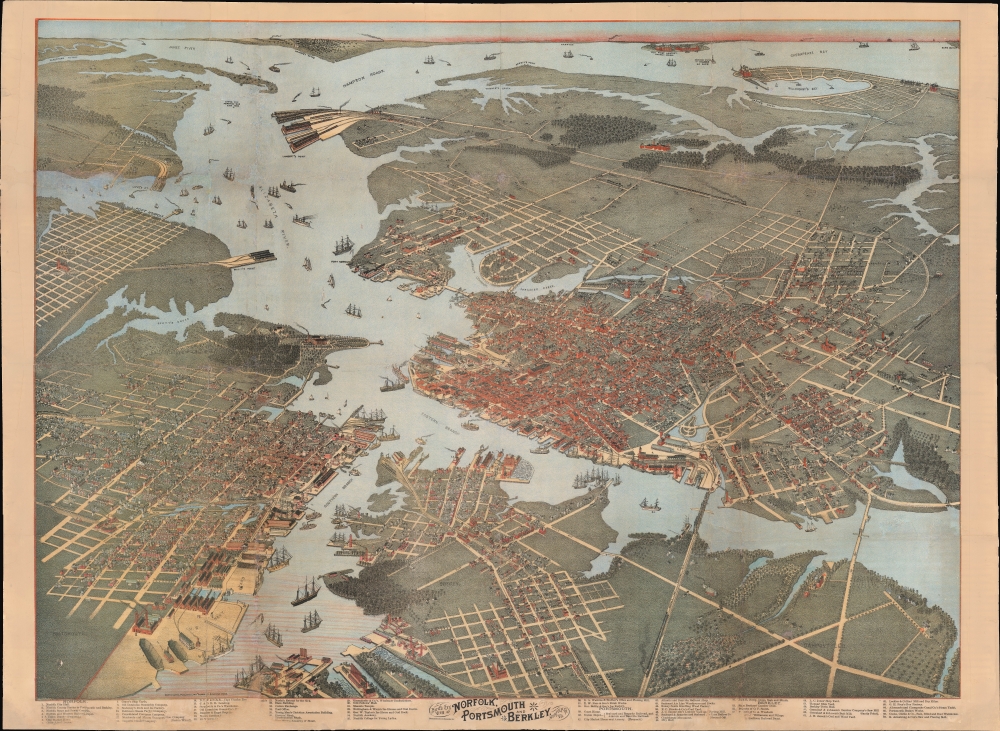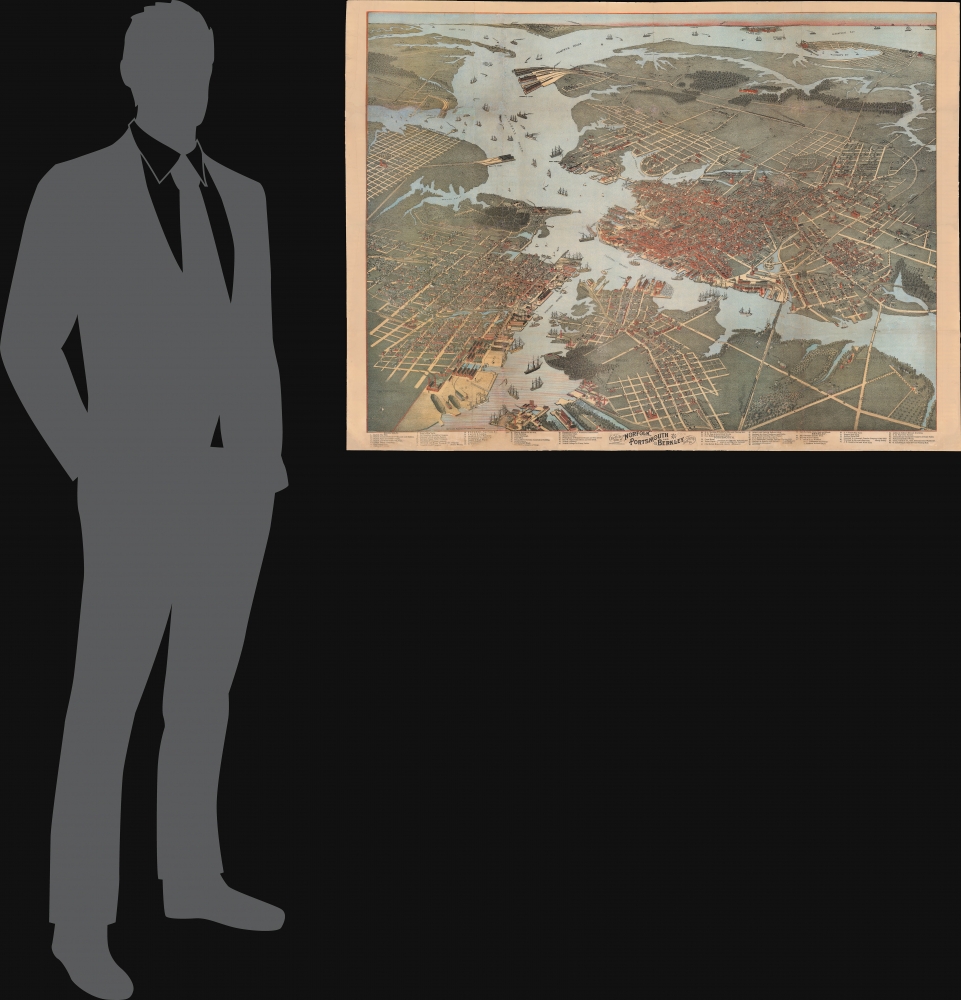This item has been sold, but you can get on the Waitlist to be notified if another example becomes available, or purchase a digital scan.
1891 Koch Bird's Eye View of Norfolk, Virginia and Vicinity
NorfolkVA-koch-1891
Title
1891 (undated) 32 x 44 in (81.28 x 111.76 cm)
Description
A Closer Look
Oriented towards the northwest, with the James River, Hampton Roads, and Chesapeake Bay in the background, this high oblique view takes in Norfolk, Portsmouth, Berkeley, and Newport News. Sixty-seven landmarks and buildings are numbered throughout, corresponding to an index at bottom, while other sites are labeled on the view itself where space allows. The expected future growth of the cities is evident with areas where a street grid has been laid out but with few to no buildings, as in the nearly empty streets of northern Portsmouth at left towards top. Some of the projects envisioned were not ultimately built. For instance, the proposed statue of Christopher Columbus in Hampton Roads was never realized, but had been advocated for prior to and during an International Naval Rendezvous in 1893 to celebrate the 400th anniversary of Columbus' voyage to the New World.Military and Naval Significance
The area's importance for military and naval history is readily evident. The U.S. Navy Yard (Norfolk Naval Shipyard), the oldest such shipyard in the United States, lies in foreground at left. At top towards right is Fort Monroe, notable for remaining in Union hands throughout the American Civil War (1861 - 1865), even as the surrounding territory fell or pledged loyalty to the Confederacy. A note marks the location where the USS Merrimack was sunk, deliberately by the Union side at the start of the Civil War. Afterwards the Confederates dredged it up and used the hull to construct a ram (redubbed CSS Virginia), with which they hoped to literally break through Union ships blockading Hampton Roads. The ship participated in the 1862 Battle of Hampton Roads, which was indecisive but highly significant for including the first naval combat between ironclad warships, the Merrimack / Virginia and the Monitor.Railroads and Shipbuilding
Norfolk emerged in the late 19th century as one of the main railway hubs in the American South. Here we can see multiple railroads reaching to seaside terminals, including Lambert's Point, Pinner's Point, and Love's Point. Multiple facilities belong to the Norfolk and Western, which was growing at a tremendous pace in these years, fed by profits made by transporting coal from western Virginia and West Virginia, particularly the Pocahontas coalfields, which the railway's president Frederick J. Kimball helped to develop.With very healthy revenues at its disposal, the Norfolk and Western would soon buy up most, though not all, of the other lines seen here. One notable exception was the Seaboard and Roanoke Railroad, which merged in 1881 with other lines to form the Seaboard Air Line Railroad; though it continues to use its earlier name here, its offices are combined with the Seaboard Air Line (number 47 on the view).
The railroads tied in with coastal shipping, which, along with the long-established U.S. Navy Yard, made Norfolk and Newport News the logical location for building modern, steel-hulled ships. Some of the biggest investors and industrialists in the U.S. saw the opportunity the region presented and bet big on its future success. Most notably, Collis P. Huntington (1821 - 1900), one of the 'Big Four' railroad-industrialists of early California, devoted resources to the establishment of Newport News as a shipbuilding center. Having already invested heavily in the Chesapeake and Ohio Railroad, which like the Norfolk and Western derived profits from the coal fields of western Virginia and West Virginia, Huntington recognized the potential of Newport News, then still a small unincorporated community.
After extending the Chesapeake and Ohio to a new coal pier at the location, he then founded the Newport News Shipbuilding and Drydock Company and built a state-of-the-art drydock facility at Newport News which could construct a variety of ships, ranging from tugboats to passenger steamships and U.S. Navy gunboats. After Collis' death, his nephew Henry Huntington took over operations of the shipyard and deepened cooperation with the government, producing several of the U.S. Navy's earliest dreadnoughts. During World War II (1939 - 1945), Naval Station Norfolk was established at Sewell's Point, across the Hampton Roads from Newport News, solidifying the area's dominance of shipbuilding and naval facilities for decades to come.
American Bird's-Eye City Views
The tradition of the bird's-eye city view emerged in the United States in the middle part of the 19th century and coincided with the commercial development of lithographic printing. Before the rise of lithography, the ability to own and display artwork in the home was largely limited to the extremely wealthy, the advent of lithographic printing made it possible for everyone to own visually striking artwork. A robust trade developed in portraits of political leaders, allegorical and religious images, and city views.City views were being produced in the United States as early as the 1830s, but the genre exploded after the American Civil War (1861 - 1865). Bridging the gap between maps and pictures, most 19th century American bird's-eye views presented cities to the public from high vantage points. Some were imagined, but others were drawn from hot-air balloons or nearby hills. The presentation, combining high elevation, commercial interest, and new printing technology, created a uniquely American art form, as described by historian Donald Karshan
Some print connoisseurs believe that it was only with the advent of the full-blown city-view lithograph that American printmaking reached its first plateau of originality, making a historical contribution to the graphic arts. They cite the differences between the European city-view prints and the expansive American version that reflects a new land and a new attitude toward the land.The vogue for bird's-eye city views lasted from about 1845 to 1920, during which period some 2,400 cities were thus portrayed, some multiple times. Although views were produced in many urban centers, the nexus of view production in the United States was Milwaukee, Wisconsin. The major American viewmakers were Stoner, Wellge, Bailey, Fowler, Hill, Ruger, Koch, Burleigh, Norris, and Morse, among others.
Chromolithography
Chromolithography, sometimes called oleography, is a color lithographic technique developed in the mid-19th century. The process involved using multiple lithographic stones, one for each color, to yield a rich composite effect. Oftentimes, the process would start with a black basecoat upon which subsequent colors were layered. Some chromolithographs used 30 or more separate lithographic stones to achieve the desired product. Chromolithograph color could also be effectively blended for even more dramatic results. The process became extremely popular in the late 19th and early 20th centuries, when it emerged as the dominant method of color printing. The vivid color chromolithography produced made it exceptionally effective for advertising and propaganda imagery.Publication History and Census
This view was copyrighted, published, and drawn by Augustus Koch, while printing was handled by the Savannah Morning News. (Koch and the newspaper also collaborated on a similar view of Savannah, published around the same time as this one.) The present view is undated, but the Library of Congress suggests a date of 1891. In the distance, Newport News lacks its famous dry dock, which was founded in 1886 and built its first ship in 1891, so the date of the view may be somewhat earlier than 1891. However, railroad lines are visible near Newport News, presumably the extension of the Chesapeake and Ohio Railroad, which immediately preceded the opening of the dry dock.A rare and stunning work, the only other known example of this view is held by the Library of Congress (Pennsylvania State University is listed as holding an example in the OCLC but this proves to be a link to the Library of Congress' digitized image of their example).
Cartographer
Augustus Koch (October 15, 1834 - 1901), active in the late 19th century, was one of the most prolific and widely traveled artists specializing in American city bird's-eye views. Koch was born in Birnbaum, Germany where, according to his superior officers in the Engineers Office of the Wisconsin Infantry during the Civil War, he received an excellent education. Some have speculated that he may have immigrated to the United States young and been educated here, but this seems unlikely as he retained a very strong German accent throughout his life. Koch enlisted as a private in the Wisconsin regiment during the American Civil War. He applied and was approved for an officer's commission in 1863. He was assigned as engineering officer to one of the black regiments serving in the Lower Mississippi Valley. There is produced several maps including one of Vicksburg. Koch started producing bird's-eye views after the Civil War with his first published view, Cedar Falls, Iowa, appearing around 1868. Koch may have apprenticed with Albert Ruger, another important Wisconsin view maker, and it may have been Ruger who introduced him to Joseph Stoner, who published many of his most significant views. According to John W. Reps, in Views and Viewmakers of Urban America (Page185),
Koch drew his cities with considerable care, consistently depicting his subjects as if seen from very high viewpoints. The horizon lines appear close to the tops of the images, and the body of each print is thus full of urban detail. Koch also used a distinctive format, making his horizontal dimension not much greater than the vertical.The date of Koch's death is unknown. His career saw the publication of some 110 views in at least 23 different states. More by this mapmaker...




